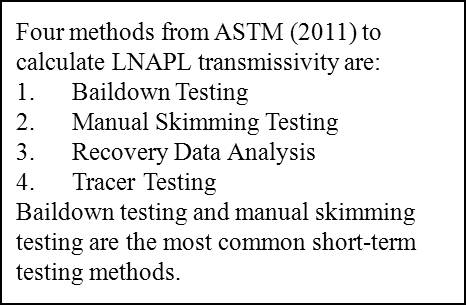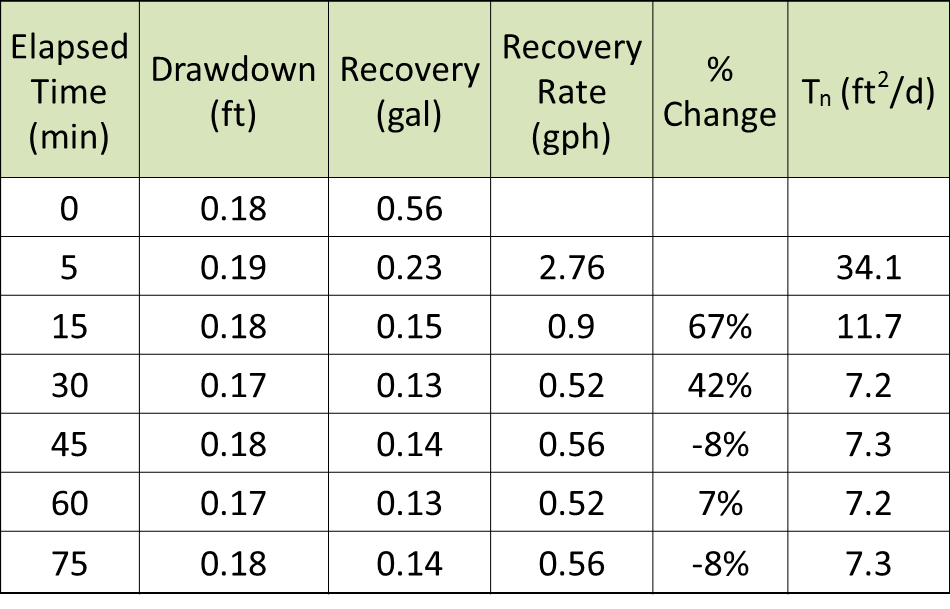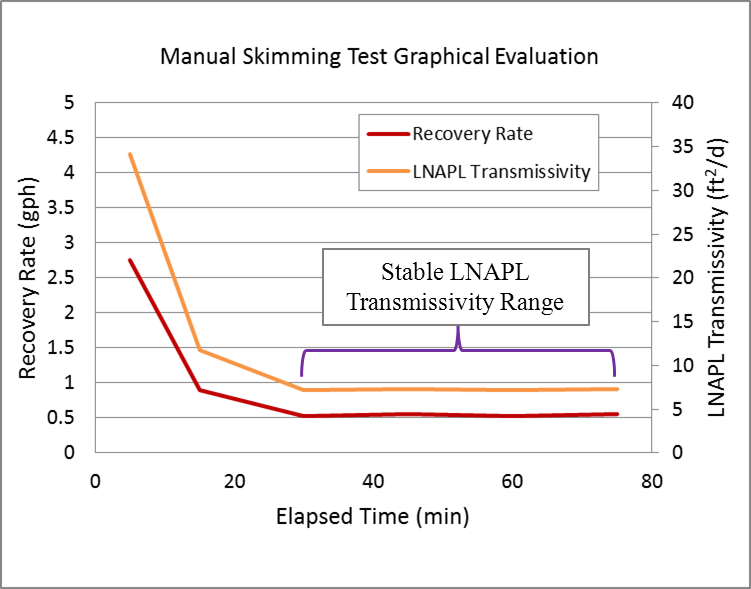Applied NAPL Science Review
Demystifying NAPL Science for the Remediation Manager
Editor: J. Michael Hawthorne, PG
Asst. Editor: Dr. Rangaramanujam Muthu
ANSR Scientific Review Board
J. Michael Hawthorne, PG, Board of Chairman, GEI Consultants Inc.
Mark Adamski, PG, BP Americas
Stephen S. Boynton, PE, LSP, Subsurface Env. Solutions, LLC
Dr. Randall Charbeneau, University of Texas
Dr. Sanjay Garg, Shell Global Solutions (US) Inc.
Dr. Terrence Johnson, USEPA
Andrew J. Kirkman, PE, BP Americas
Mark Lyverse, PG, Chevron Energy Technology Company
Mark W. Malander, ExxonMobil Environmental Services
Applied NAPL Science Review (ANSR) is a scientific ejournal that provides insight into the science behind the characterization and remediation of Non-Aqueous Phase Liquids (NAPLs) using plain English. We welcome feedback, suggestions for future topics, questions, and recommended links to NAPL resources. All submittals should be sent to the editor.
Manual Skimming Testing to Measure
LNAPL Transmissivity
Andrew Kirkman, PE – BP Americas
 Transmissivity of light non-aqueous phase liquid (LNAPL) is a powerful metric to evaluate hydraulic recoverability, just as groundwater transmissivity is for groundwater. LNAPL frequently exhibits substantial variations in transmissivity over time and across small distances. Therefore, multiple measurements of LNAPL transmissivity (Tn) over time and spatial scales are used to adequately characterize LNAPL recoverability across most sites. Characterization is aided by the availability of short-term LNAPL transmissivity test methods that are applicable to a wide variety of conditions. ASTM (2011) provides three methods for short-term measurement of LNAPL transmissivity: 1) baildown testing, 2) manual skimming testing, and 3) LNAPL/water ratio testing of short-term recovery data. A fourth method, tracer testing, typically requires months to complete, so is not useful for multiple, small-scale, rapid assessments of LNAPL transmissivity. This article provides an introduction to manual skimming testing.
Transmissivity of light non-aqueous phase liquid (LNAPL) is a powerful metric to evaluate hydraulic recoverability, just as groundwater transmissivity is for groundwater. LNAPL frequently exhibits substantial variations in transmissivity over time and across small distances. Therefore, multiple measurements of LNAPL transmissivity (Tn) over time and spatial scales are used to adequately characterize LNAPL recoverability across most sites. Characterization is aided by the availability of short-term LNAPL transmissivity test methods that are applicable to a wide variety of conditions. ASTM (2011) provides three methods for short-term measurement of LNAPL transmissivity: 1) baildown testing, 2) manual skimming testing, and 3) LNAPL/water ratio testing of short-term recovery data. A fourth method, tracer testing, typically requires months to complete, so is not useful for multiple, small-scale, rapid assessments of LNAPL transmissivity. This article provides an introduction to manual skimming testing.
Manual skimming testing consists of repeatedly removing LNAPL from a well to maintain LNAPL drawdown and establish a sustainable LNAPL production rate for a given LNAPL drawdown. LNAPL transmissivity can then be estimated from the test results (ASTM, 2011).
A typical manual skimming test consists of bailing or pumping all possible LNAPL from a well, gauging the well as the LNAPL recharges, removing LNAPL again before the recharge reaches 25 percent of the pre-test apparent NAPL thickness (ANT) gauged in the well, and repeating this process until the LNAPL removal rate has stabilized. Some water removal is inevitable depending upon the equipment utilized, but water induced drawdown should be minimized.
Between each LNAPL removal step the volume of LNAPL and water removed is carefully measured. Based on the time between removal steps and the volume of LNAPL removed, the rate of LNAPL removal may be calculated for each LNAPL removal step. LNAPL transmissivity may then be calculated from the sustained LNAPL removal rates and associated LNAPL drawdowns gauged in the well.
The advantages of manual skimming testing are:
- Improved accuracy of LNAPL transmissivity estimates over baildown tests for wells with small pre-test gauged apparent NAPL thicknesses (i.e., <0.5 foot). Baildown test analyses at these wells require measurement of very small changes in LNAPL drawdown (e.g., 0.01-0.02 foot). A downhole gauging error of only 0.01 foot (limit of measurement for downhole electronic interface probes) represents a very large percentage error for these small drawdowns. In manual skimming testing the total drawdown achieved is used instead of small incremental changes in drawdown. Combined with the ability to accurately measure removed LNAPL volumes aboveground in appropriately sized graduated cylinders, manual skimming testing substantially reduces the effect of small scale measurement errors and therefore may provide more accurate calculated LNAPL transmissivity values for wells with pre-test apparent NAPL thicknesses of less than 0.5 foot.
- Improved understanding of LNAPL recovery behavior in dynamic environments (e.g., tidal or remediation system capture zone wells). Care must be taken to accurately estimate the manual skimming test drawdown in these environments as it can vary throughout the test period. If drawdown cannot be accurately estimated, manual skimming testing still provides a valuable measurement of sustainable LNAPL recovery, but calculated LNAPL transmissivity accuracy will suffer.
- Improved understanding of equilibrium conditions and vertical LNAPL distribution. The collection of recharge gauging data to equilibrium conditions following the conclusion of the manual skimming test can result in a full discharge versus drawdown (DvD) graph for the mobile NAPL and verification of equilibrium fluid levels.
Manual skimming testing is based on the steady state Theim equation, which has been utilized to model LNAPL recovery from LNAPL skimming remediation wells (Charbeneau, 2007). Detailed manual skimming testing guidance is provided in ASTM (2011).
Tools: The equipment to conduct a manual skimming test includes an electronic interface probe, an appropriately sized graduated cylinder, a time-keeping device, and an intrinsically safe pump or bailer. Data may be recorded manually or electronically. Vacuum trucks and similar equipment for removing LNAPL are not recommended, though they can be used with caution in the hands of experienced testers.
Test Steps: A manual skimming test consists of three steps:
- Repeated LNAPL removal with minimal water removal
- Calculation of LNAPL recovery rate for each removal
- Calculation of LNAPL transmissivity

Calculated LNAPL recovery rates for each LNAPL removal period should be evaluated graphically and numerically. A test is complete when the recovery rates have stabilized within a variation of 25 percent over three successive recovery values that do not exhibit a continuous increasing or decreasing trend. The following example presents results of an idealized skimming test and the corresponding calculated LNAPL transmissivity (Tn).


Once the sustainable LNAPL recovery/recharge rate and drawdown data are obtained, estimated LNAPL transmissivity is calculated from the following formula:

Care should be taken to ensure consistency of units in the calculation. To calculate LNAPL transmissivity (Tn) in feet squared per day (ft2/d), the NAPL recharge rate should be in cubic feet per day (ft3/d) and NAPL drawdown should be in feet (ft).
The radius of skimming influence (Roi) and effective well radius (rw) are rarely known accurately, but these variables are part of a logarithmic term that can be replaced with an assumed value of 4.6 (assuming Roi/rw is equal to 100) without introducing substantial error (i.e., less than 20 percent based on pilot test results). LNAPL drawdown (sn) is the geometric mean of the measured LNAPL drawdown for each NAPL removal period.
Substantial error can be induced if equilibrium fluid levels are unknown and accurate drawdown cannot be calculated (e.g., tidal zones), though manual skimming testing still provides sustainable LNAPL removal rates for wells even when accurate LNAPL transmissivity values cannot be calculated. Post-test verification of equilibrium fluid levels will provide higher confidence in transmissivity values.
The following suggestions are provided as best practices:
- Minimize water production for each LNAPL removal step.
- Maximize LNAPL recharge between each LNAPL removal step up to the 25 percent initial apparent NAPL thickness threshold to minimize removed LNAPL volume measurement errors.
- Use the same time-keeping device throughout the test, measuring to the nearest second for the start and stop times for LNAPL removal.
- Analyze and/or plot data prior to leaving the field to ensure test objectives are met before stopping the test.
- Understand the LNAPL hydrogeologic conditions for every well to be tested and calculate drawdown accordingly (Kirkman et al, 2012).
- Utilize hydrographs or plots of stabilized apparent NAPL thickness versus log-time to confirm equilibrium fluid levels.
A Word of Caution: Manual skimming testing is analogous to aquifer pumping testing. Consistency of testing methods, accuracy of measurements, and a clear understanding of the site/well LNAPL conceptual site model are critical to successful testing and accurate LNAPL transmissivity calculation. LNAPL drawdown and recovery rates are important variables and errors in their estimation or measurement will result in reduced accuracy of estimated LNAPL transmissivity values. As with any test of aquifer characteristics, results should be interpreted within the overall context and objectives for the site.
Charbeneau, Randall (2007) LNAPL Distribution and Recovery Model (LDRM), Volume 1: Distribution and Recovery of Petroleum Hydrocarbon Liquids in Porous Media. API Publication 4760, January 2007, American Petroleum Institute Regulatory and Scientific Affairs Department, 53 pp.
Kirkman, A.J., Adamski, M.R., Hawthorne, J.M., 2012, Identification and Assessment of confined and perched LNAPL Conditions, Groundwater Monitoring and Remediation, published on-line July 26 2012.
Related Links
API LNAPL Resources
ASTM LCSM Guide
Env Canada Oil Properties DB
EPA NAPL Guidance
ITRC LNAPL Resources
ITRC LNAPL Training
ITRC DNAPL Documents
RTDF NAPL Training
RTDF NAPL Publications
USGS LNAPL Facts
ANSR Archives
Coming Up
Look for more articles on LNAPL transmissivity as well as additional explanations of laser induced fluorescence, natural source zone depletion and LNAPL Distribution and Recovery Modeling in coming newsletters.
Announcements
An updated version of the ASTM Guide for Calculating LNAPL Transmissivity is Now Available for Purchase at www.astm.org.
ASTM Standard E2856 – Standard guide for Estimation of LNAPL Transmissivity is now available
The ASTM LNAPL Conceptual Site Model (LCSM) workgroup is actively updating the ASTM LCSM guidance document. If you are interested in participating on this team or would like to send comments for consideration – please contact Andrew Kirkman of BP Americas (team leader).
ANSR now has a companion group on LinkedIn that is open to all and is intended to provide a forum for the exchange of questions and information about NAPL science. You are all invited to join by clicking here OR search for “ANSR – Applied NAPL Science Review” on LinkedIn. If you have a question or want to share information on applied NAPL science, then the ANSR LinkedIn group is an excellent forum to reach out to others internationally.
